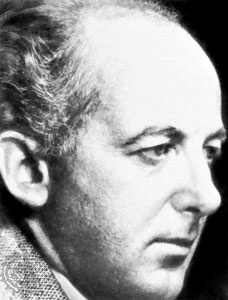Cowell, Henry
American composer
in full Henry Dixon Cowell
born March 11, 1897, Menlo Park, California, U.S.
died December 10, 1965, Shady, New York
 American composer who, with Charles Ives (Ives, Charles), was among the most innovative American composers of the 20th century.
American composer who, with Charles Ives (Ives, Charles), was among the most innovative American composers of the 20th century.Cowell grew up in poverty in San Francisco and on family farms in Kansas, Iowa, and Oklahoma. He acquired a piano at age 14, and the following year he gave a concert of his experimental piano compositions. At 17 he studied at the University of California with the influential musicologist Charles Seeger, who persuaded him to undertake the systematic study of traditional European musical techniques. He also urged Cowell to formulate a theoretical framework for his innovations, which he did in his book New Musical Resources (1919; published 1930), an influential technical study of music. While studying comparative musicology (ethnomusicology) in Berlin with Erich von Hornbostel (Hornbostel, Erich Moritz von), Cowell became interested in the music of other cultures; he later studied Asian and Middle Eastern music, elements of which he absorbed into many of his own compositions.
In 1923–33 Cowell undertook a series of tours of Europe as composer and pianist. Many of his concerts provoked uproar, but they also brought him to the attention of leading modern European composers. He taught at the New School for Social Research in New York City in 1932–52 and, from 1949, at Columbia University. From 1936 to 1940 he was incarcerated in San Quentin state prison on charges of homosexual conduct. He continued to write music while in prison, and in 1940 he was paroled to the custody of composer Percy Grainger (Grainger, Percy). Cowell was granted a full pardon in 1942.
Cowell's innovations appear particularly in the piano pieces written between 1912 and 1930. Seeking new sonorities, he developed “tone clusters,” chords that on the piano are produced by simultaneously depressing several adjacent keys (e.g., with the forearm). Later he called these sonorities secondal harmonies—i.e., harmonies based on the interval of a second in contrast to the traditional basis of a third. These secondal harmonies appear in his early piano pieces, such as The Tides of Manaunaun (1912); in his Piano Concerto (1930); and in his Synchrony (1931) for orchestra and trumpet solo. Some of his other piano compositions, such as Aeolian Harp (1923) and The Banshee (1925), are played directly on the piano strings, which are rubbed, plucked, struck, or otherwise sounded by the hands or by an object. Cowell's Mosaic Quartet (1935) was an experiment with musical form; the performers are given blocks of music to arrange in any desired order. With the Russian engineer Leon Theremin, Cowell built the Rhythmicon, an electronic instrument that could produce 16 different simultaneous rhythms, and he composed Rhythmicana (1931; first performed 1971), a work specifically written for the instrument.
Cowell wrote numerous pieces reflecting his interest in rural American hymnology, Irish folklore and music, and non-Western music. In order to publish the scores of modern composers, he founded the New Music Quarterly in 1927 and was its editor until 1936. He also edited American Composers on American Music (1933) and with his wife, Sidney Cowell, wrote Charles Ives and His Music (1955). A number of well-known American composers, including John Cage (Cage, John), Lou Harrison, and George Gershwin (Gershwin, George), studied with and were influenced by Cowell.
Additional Reading
Martha L. Manion, Writings About Henry Cowell: An Annotated Bibliography (1982); William Lichtenwanger, The Music of Henry Cowell: A Descriptive Catalog (1986).
- Venustiano Carranza
- Venus Williams
- Venyukovia
- Vera Charlotte Scott Cushman
- Veracruz
- Veracruz incident
- Vera Francevna Menchik-Stevenson
- Vera Fyodorovna, Countess Muravyova Komissarzhevskaya
- Vera Fyodorovna Komissarzhevskaya, Countess Muravyova
- Vera Ivanovna Zasulich
- Veralden-radien
- veranda
- Vera Nikolayevna Figner
- Veratrum
- Veraval
- Vera Volkova
- Verbania
- Verbena
- Verbenaceae
- Verbiest, Ferdinand
- Vercelli
- Vercelli Book
- Vercingetorix
- Vercors
- Verde, Cesário